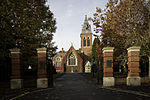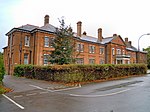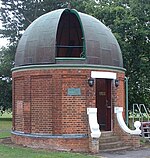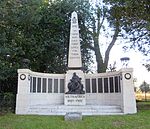St Andrew's Garrison Church, Aldershot
Buildings and structures in AldershotChurches in AldershotGrade II listed churches in HampshireHistory of HampshireMilitary in Aldershot ... and 1 more
Use British English from September 2013

St Andrew's Garrison Church, situated at Queens Avenue, Aldershot, Hampshire (GU11 2BY) in southern England is a large army church designed in the late 1920s by the prominent Scottish architect Sir Robert Lorimer (1864–1929).
Excerpt from the Wikipedia article St Andrew's Garrison Church, Aldershot (License: CC BY-SA 3.0, Authors, Images).St Andrew's Garrison Church, Aldershot
Queen's Avenue, Rushmoor North Town
Geographical coordinates (GPS) Address External links Nearby Places Show on map
Geographical coordinates (GPS)
| Latitude | Longitude |
|---|---|
| N 51.260833333333 ° | E -0.75916666666667 ° |
Address
St. Andrew's Garrison Church
Queen's Avenue
GU11 2BY Rushmoor, North Town
England, United Kingdom
Open on Google Maps










